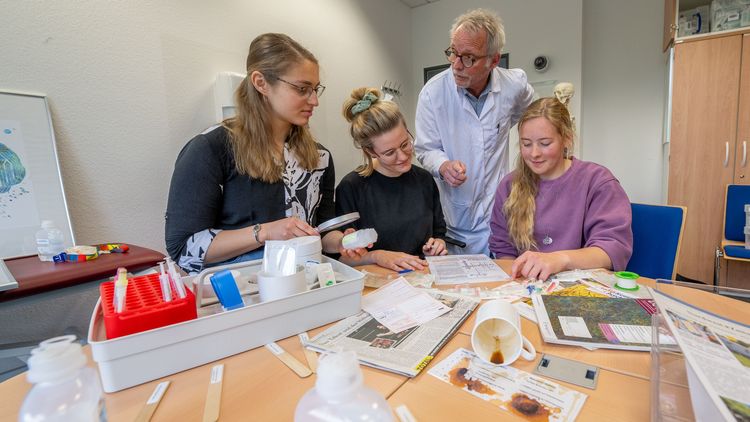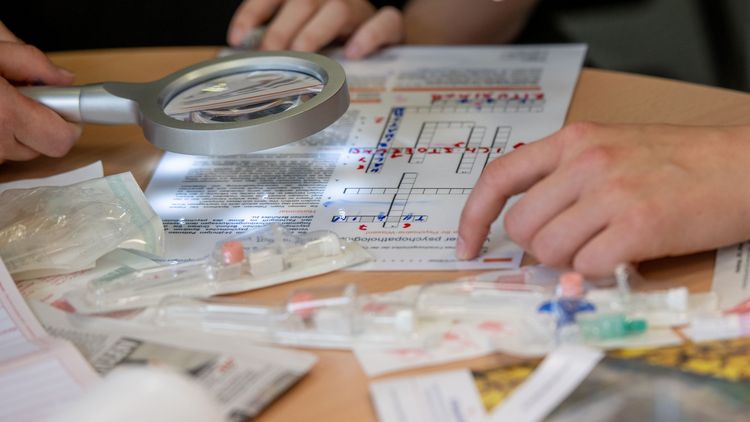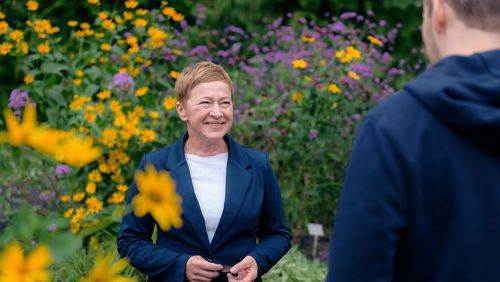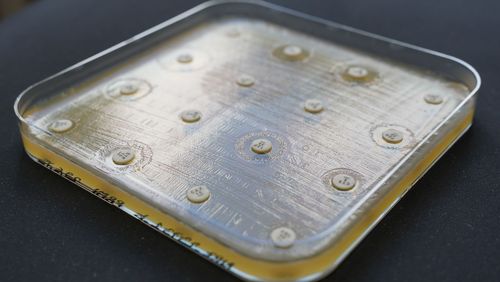The University is offering a new and unusual class for medical students. In Escape Room Neurology, they have just 90 minutes to apply their medical knowledge to solve puzzles and prevent a cyberattack while contending with an odd assistant who keeps trying to distract them from their tasks.
Medical educationalist Thomas Schmidt and neurologist Dr Wiebke Grashorn stare, mesmerised, at a live video broadcast showing what's going on in the room next door. The room has been equipped to look like a doctor's consulting room and is part of the university's Clinical Training Centre. Normally it is used by medical students for examining simulated patients, but today the screen shows a very different scenario: one medical student is rummaging around in a cupboard, another is inspecting a combination lock and a third is poring over a crossword puzzle. Suddenly a man in scrubs storms into the room. He stands there looking confused, crosses to the sink, turns on the tap, and then takes a white coat from a hook on the wall and drops it on the floor. He then leaves the room as the three female students watch with baffled looks on their faces.
The three medical students, Aparajita Weimer, Luise Roth and Katharina Meier, are currently experiencing what is perhaps the most unusual class in their entire study programme: Escape Room Neurology. A team led by Thomas Schmidt designed the adventure learning experience. "We wanted to create a playful learning method for medical studies," he explains. The class is modelled on the Escape Rooms which have been luring game enthusiasts in cities all over the world for some years now, with the challenge of being locked in a room where they must solve puzzles and complete tasks to achieve a specified goal within a limited amount of time. Each Escape Room has its own theme, for example escaping from a prison, or visiting a power plant and having to prevent an impending meltdown.
Students slip into a role
The three medical students Aparajita, Luise and Katharina face a different challenge, however. They have slipped into the role of new employees at the fictitious Neurological Research Institute Oldenburg and now have 90 minutes to locate and open a hidden safe. A Mr. Bartholomé, who introduced himself as the assistant director of the institute, has told them that only the information contained in the safe can prevent a cyberattack on the institute.
To access the code for the safe, the students must solve a number of puzzles. In the office of the institute's director, Dr Frank N. Stein, who, as they have been informed by Mr Bartholomé, has recently passed, they find numerous clues: medical files, suspicious drugs, a password-protected laptop, scientific journals, and even a crossword puzzle designed by puzzle enthusiast Dr. Stein and published in a scientific journal. Normal escape room fans would hardly stand a chance in this medical adventure. But Aparajita, Luise and Katharin are able to apply the knowledge of neurology they have acquired during their studies, filling in the right technical terms in crossword puzzles, making correct initial diagnoses, prescribing the right medications based on medical tests and brain scans and thus solving one puzzle after another.
Wiebke Grashorn, a medical doctor, listens to the three students' deliberations via microphones installed in the Escape Room. Grashorn notes down the ideas and solutions they come up with – the good as well the bad – so that she can discuss their level of knowledge with them afterwards. After all, despite all the fun the students are clearly having, the whole point of the Escape Room is to learn and become aware of gaps in their own knowledge. The medical expert can also intervene in the game and give the students tips and clues via the microphone when they're completely stumped. Aparajita, Luise and Katharina don't need many tips, but they still get nervous. After all, the clock is ticking.
Funded by the Innovation Plus programme
"Doctors must be able to remember what they have learned even in stressful situations. The Escape Room provides a safe environment in which students can practise this – but where they are also allowed to make mistakes without having to fear serious consequences," says Schmidt.
Ulf Goerges adds an additional stress factor to the game. A professional actor, his job is normally to train and coordinate the simulated patients with whom medical students practise their communication skills. Today, however, he has slipped into the role of Mr Bartholomé, a scatter-brained assistant at the institute who keeps distracting the students from their tasks. He was also a member of the team that developed the game, as were former medical student Barbara Filser, who created most of the puzzles, and student teacher Etienne Légat. Having worked at a real Escape Room, Légat had plenty of experience, and in his Bachelor's thesis he even designed an outdoor Escape game for Oldenburg. Grashorn and neurologist Dr Fabian Fincke added their medical expertise to the mix. Now they take it in turns to supervise the sessions.
The Innovation Plus programme of the Lower Saxony Ministry of Science and Culture approved the funding for the innovative teaching concept in 2019, but shortly before the Escape Room was completed the Covid-19 pandemic broke out and the distancing rules prevented its implementation.
In the meantime, however, this unusual class has become a permanent fixture of the teaching programme – and feedback from the participants has been consistently positive. "I was surprised that we were still able to explain things to each other despite the time pressure," comments Luise Roth once the game has ended. The puzzle room, with its many unsolved questions, was not as far removed from everyday life in a hospital as one might expect, she adds. "At the hospital you often have to grapple with lots of loose threads that need to be brought together," Luise notes. With this remark she describes several other learning goals which the development team had in mind when it designed the room: to improve communication skills, problem-solving skills and critical thinking.
To determine how powerful the learning effect of the Escape Room is, the teaching staff have students complete multiple choice tests both before and after the game. The results of their experiments are to be published later on. But for Dr. Wiebke Grashorn, even more important than the research aspect is that the participants experience what it is like to have to remember what they have learned during their studies in a stress situation. "There are basics that you simply have to be able to remember in every situation. If a bacterial meningitis is not diagnosed in time, for example, a person can die."





